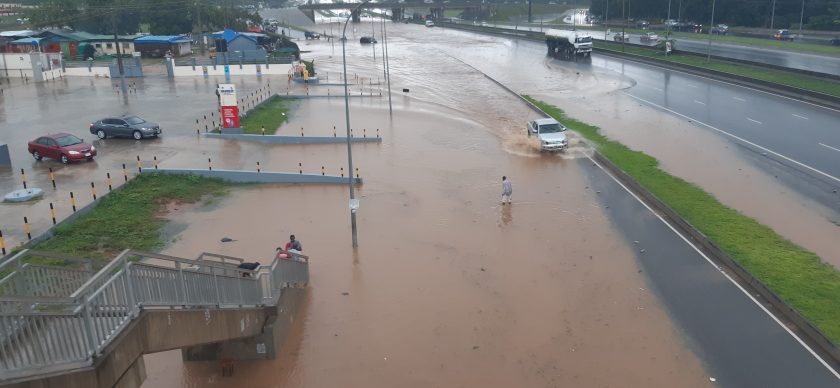This catastrophic flooding must not happen again
Recent weeks have been a season of pain and anguish for Nigerians caught up in the recurring floods across the country. Spreading across 27 out of 36 states and the FCT, the National Emergency Management Agency (NEMA) said the floods have affected half a million people, displacing 100,000 people. It added that more than 300 […]

flooding
Recent weeks have been a season of pain and anguish for Nigerians caught up in the recurring floods across the country. Spreading across 27 out of 36 states and the FCT, the National Emergency Management Agency (NEMA) said the floods have affected half a million people, displacing 100,000 people. It added that more than 300 people have so far been killed in 2022 and about 500 injured; making it the worst devastation in a decade.
In Jigawa State, one of the worst-hit, 40 people reportedly lost their lives while thousands of others were displaced and farmlands submerged. Taraba, another severely hit state, suffered monumental losses that include destruction of thousands of hectares of rice farms across five local government areas of the state. In Niger State, 20 out of the 25 LGAs are said to have been hit by floods. Over 500 corpses in Mariga town of the state were washed away from cemeteries by floods with only 200 corpses recovered and re-buried.
- Flood: 500 dead, 1.4m affected in 31 states, Abuja – FG
- Cholera kills 233 in 31 states as 173 die of Lassa fever
In Benue, the Commissioner for Environment and Water Resources blamed the problem on the lack of dredging of the Benue River. In Kano, 19 of the 44 LGAs have been affected; leaving 23 persons dead, 106 injured, 12,919 houses destroyed, and 14,496 farmlands devastated in five LGAs. In Kogi State, the Lokoja-Abuja highway and communities in the riverine areas of Kotonkarfe were submerged, leading to fuel scarcity in the FCT. Several other states are still counting losses.
Reacting, President Muhammadu Buhari noted that the flooding is a setback to agriculture, which he said “is the largest employer of labour and a major source of income for most Nigerians,” adding that the destruction of rice farms in Jigawa State is bad news, not only for the victims but also for the government’s policy of achieving food sufficiency and security in the country.
In August 2022, the Director-General of NEMA, Mr Mustapha Ahmed, said 233 LGAs in 32 states and the Federal Capital Territory (FCT) had been predicted to experience flooding. This followed the 2022 Seasonal Climate Prediction released by the Nigerian Meteorological Agency (NiMet) and the Annual Flood Outlook released by the Nigeria Hydrological Services Agency (NIHSA). The poor response that welcomed the floods, however, revealed how unprepared relevant government agencies were.
We condemn the authorities for reportedly admitting that the situation is “beyond our control” because the flooding was not a sudden occurrence. The excuse, too, which partly blamed this year’s havoc on the release of excess water from the Lagdo dam in neighbouring Cameroon, is rather irresponsible because that was not unexpected.
Ten long years after the 2012 flooding in Lokoja and other places, the country learnt no lessons. Out of the N17.6 billion voted by former President Jonathan for the Flood Relief and Rehabilitation Committee to provide succour to affected communities, N13.3 billion was allocated to the states and N4.3 billion to federal government agencies. President Jonathan directed that part of the money should be used for the resettlement of the people affected. Nothing much was heard about that after the rains stopped.
The recurring flooding confirms the 2016 claim by Comrade Aminu Umar, president of the Nigerian Indigenous Ship Owners Association (NISA), that all was not well with the dredging of River Niger from Warri to Baro, which contract was awarded by late President Yar’adua in December 2008. While in office, the immediate past minister of Transportation, Rotimi Amaechi, told senators that the N34.8 billion-contract later reviewed to N43.3bn for the project had been completed.
Investigative reports show how funds meant for ecological projects designed to mitigate the burdens of climate change on vulnerable communities were diverted to non-eco schemes such as combating Ebola outbreak. The 2012-2016 NEITI Report shows that a total of N276.51 billion was allocated to the fund from December 2011 to November 2016. Governors and federal agencies have turned the fund into a ‘backup treasury’.
Were buffer dams constructed to control excess water discharged from Lagdo Dam in Cameroon; were ecological funds utilised for the purpose they were meant; were the contract for the dredging of River Niger well executed; and were the funds raised by the 2012 Presidential Committee on Flood Relief and Rehabilitation used to relocate victims from floodplain areas, the recurring ecological emergency would have been forestalled. But for the deeply-seated corruption in government agencies, the latest round of devastating floods was least averted. All this lends credence to the public insinuation that government officials benefit from devastation and grief suffered by victims, which explains their persistent application of ad hoc solutions to the problem.
While we call on government to probe and prosecute corrupt officials in all matters connected to the dredging project, ecological fund, and the funds disbursed by the 2012 Presidential Committee on Flood Relief, victims facing humanitarian crisis must not be abandoned. Nigerians should learn to comply with early warnings because their foolhardiness only worsens the devastation when the floods arrive.
This catastrophic flooding must not happen again. But unless buffer dams are built along River Benue, siltation (sand deposit) is reduced in the River Niger, and residents of flood-prone areas relocated once and for all to safer zones, the country may not have seen the worst flooding.
